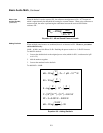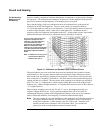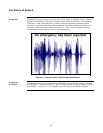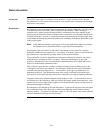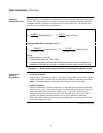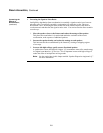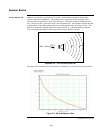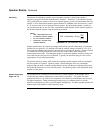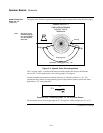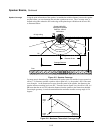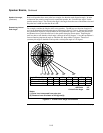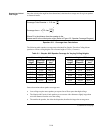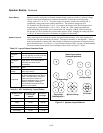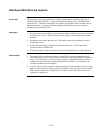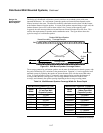
2-10
The amount of sound that a speaker can be expected to produce is found in the speaker’s
sensitivity rating provided in the manufacturer’s literature. “Sensitivity” is the amount of sound
(SPL) produced by the speaker with a known signal frequency, power level and distance from the
speaker. For fire alarm listed speakers approved under UL Standard 1480, the sensitivity is rated
at 1 W of power and 10 feet (3 meters) from the speaker. By knowing the speaker’s sensitivity,
you can determine the on-axis SPL (SPL measurements taken directly in-line with the speaker) at
any distance from the speaker using the following equation:
SPL = Sensitivity + 20 log
⎥
⎦
⎤
⎢
⎣
⎡
D
Dr
Equation 2-9. On-Axis SPL Calculation
Simplex speakers have two sensitivity ratings listed on their respective data sheets, a reverberant
chamber test as required by UL Standard 1480 and an anechoic rating as defined by ULC-S541.
The reverberant chamber specification is derived from a test where the speaker’s sound is emitted
in a chamber specifically designed to reflect all of the sound so that a total sound power
measurement can be made. Correlating the speaker’s reverberant chamber sensitivity rating with
real-world acoustics has proven to be difficult. Typically, the anechoic rating at 1 kHz is more
representative of real world performance.
The speaker sensitivity rating, while useful for comparing speaker models, tends to oversimplify
the true response of a speaker. Speakers “beam” sounds analogous to the way a flashlight
produces light: the beam of sound is loudest directly in-line with the device and becomes quieter
the farther the listener moves away from the center. This beaming effect is also dependent on the
frequency of the signal.
The beaming effect is referred to as the directivity or “polar response” of the speaker, and is
occasionally provided by manufacturers in the form of “polar plots.” For typical fire alarm
speakers the beam is very wide for low frequencies (low directivity) and becomes more focused
for higher frequencies. When determining coverage area, it is common practice to use the
directivity information at 2 kHz: a critical band for intelligibility. Fire alarm speakers produce the
highest output in the 800Hz to 4 kHz frequency range.
Continued on next page
Speaker Basics, Continued
Sensitivity
Speaker Dispersion
Angle and “Q”
Where:
• SPL = Sound Pressure Level
• D = Distance from the speaker
• Dr = The reference distance
• Sensitivity = The SPL at the
reference distance.




